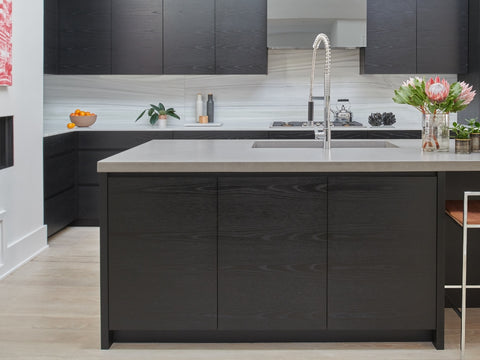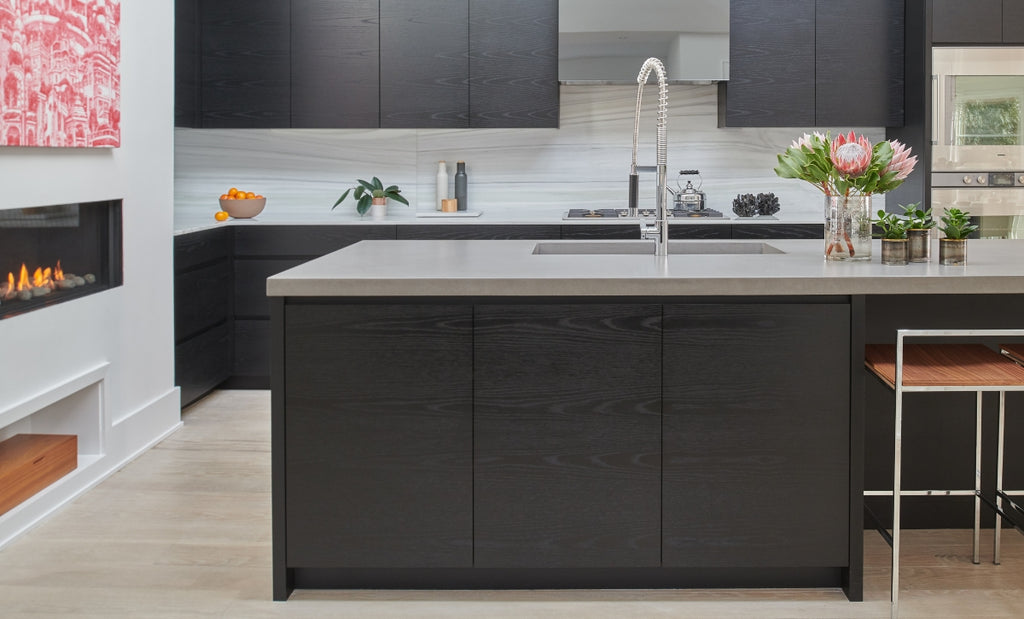
Trueform Concrete’s Step-by-Step Guide to DIY Countertop Resurfacing

Have your concrete countertops seen better days? Resurfacing countertops is much easier than it seems. Conquer your concrete resealing project today with our helpful how-to guide.
How to Know It's Time for Resealing
Despite your best efforts, normal wear and tear is inevitable. If your concrete countertop surface becomes dull or has lost its sheen—even if only in specific, high-traffic areas—it is an indicator that the surface should be resealed.
Discoloration is another indicator to watch for. Excessive heat is another common way that countertops are damaged. The concrete itself is very heat resistant, but the sealer is susceptible to high heat and may discolor. For this reason, it is not recommended to place hot items directly on your countertops - always use a trivet or hot pad to avoid any damage. Resurfacing can correct most discoloration.

Why Do Countertops Need to Be Resurfaced?
Concrete is extremely durable, but it is not invincible. Just like stone, it is inherently porous, which is why all Trueform products are sealed prior to use with our proprietary sealer: Trueseal. Without sealer, concrete absorbs liquid and makes it difficult (if not impossible) to remove stains. Regular resealing will ensure your surfaces stay protected.
Excessive wear, misuse, and accidents can all contribute to damage to the seal. Take scratches, for example. Micro-scratches are expected on most concrete surfaces as a consequence of general use. However, these scratches generally occur on the sealer and not on the concrete itself.
You can temporarily minimize the appearance of scratches by using Pledge, but more a lasting solution will be required. Note that scratches are more visible on darker colors than on lighter ones and so it may mean that darker surfaces need more frequent attention.
How Often Do Concrete Countertops Need to Be Resurfaced?
On average, resealing every 3-5 years is recommended (depending on use). A new coat of sealer will brighten the color while providing the optimum protection against potential staining.
What You Need to Get Started—Resurfacing Kits
Whether your concrete countertops are indoors or outdoors, bring them back to their original state with one of our repair kits. There are three different types to choose from.
- Sealer Repair Kit 4: The sealer repair kit 4 is intended for recoating worn or damaged sinks and other smaller surfaces. This kit includes parts A and B of the sealing solution, a rolling sleeve, a paper cup and a mixing stick, two rubber gloves, one lint-free rag and 220-grit sandpaper.
- Sealer Repair Kit 9: The sealer repair kit 9 is intended for recoating work or damaged countertops, tables, desks, and other larger surfaces. This kit includes all the same materials as sealer repair kit 4 except for the rollers. Instead of one roller, you’ll get two rollers: one for application and one for back rolling.
- Chip Repair Kit: The chip repair kit is used for repairing small edge chips. Included in the kit are two razor blades, a hardener, and colored resin.
In addition to the kits’ materials, you’ll need an orbital sander, a roller frame, paper towels, cardboard, or newspaper, painters tape, and the proper PPE (mask and eye protection).
How to Begin Your Resurfacing Project
Once you’ve gathered your materials, it’s time to get started. Before you begin mixing the concrete sealer, prepare your concrete surface by:
- Sanding Your Surface: Use the 220-grit sandpaper provided in your kit to sand the entire concrete surface. This ensures maximum adhesion of the sealer on your surface. For the best results, use a random orbital sander with 220-grit dry sanding discs. Once you’re finished, make sure there aren’t any swirls or sanding marks left behind.
- Cleaning Your Surface: After you’ve sanded the surface, use a rag to remove any excess dirt or grime, making several passes if need be. Acetone can also be used during the cleaning process if you wish.
- Taping the Surrounding Area: Take your painter's tape and tape off any surfaces or appliances that need protection from the sealer (backsplashes, walls, etc).
Once the prep work is out of the way, it’s time to mix and apply the sealing solution.

What Comes Next—Mix and Apply the Concrete Sealer
First, start by gathering parts A and B of the urethane sealing solution along with your 10 oz paper cup, wood mixing stick, and PPE. From there, follow this simple, four-step process:
- Lay down cardboard, newspapers, or paper towels to mix over in case of spills
- Open the “A” container and pour the contents into the paper cup
- Open the “B” container and pour the contents into the same paper cup
- Using the wood mixing stick, stir the contents in one direction, then switch and stir in the opposite direction. Continue to stir for two minutes while scraping the sides to incorporate the entire mixture.
After the sealer has been mixed, the application goes rather quickly. To begin:
Grab your roller.
- Starting at one corner, pour sealer onto your concrete and begin to roll it out over the surface. Make sure you’re rolling it outward from your starting point.
- Continue rolling your surface, only pouring new sealer onto areas that have already been coated.
- Once your surface is completely coated, make several more roll passes to even out the film thickness of the sealer coating.
Once you’re done with the initial coat, it’s time to start back rolling. Using the same roller, choose one side of the concrete piece, and roll backwards towards the opposite side. While you back roll, apply lighter pressure than the initial application and slightly cross over the previous line with every pass.
Your application process varies slightly depending on which sealing kit you’re using. If you’re using sealer repair kit 4, you’ll only need one roller, but if you’re using sealer repair kit 9, use a 4" x 3/8” roller for tight corners and small spaces while using a 9” x 1/4” roller for the rest.
Finishing Up
Ready for another round of recoating or sanding? Wait at least 24 hours before you begin again, making sure to use 220-grit sandpaper each time.
As for the clean-up, always follow federal, state, and local regulations on the proper handling of excess products. Our Material Safety Data Sheet goes more in-depth on how to safely dispose of waste.
Our full repair instructions can be found here, but if you live in the Tri-State area, we’ll do the repair work for you. Looking for more tips and tricks on maintaining your concrete?